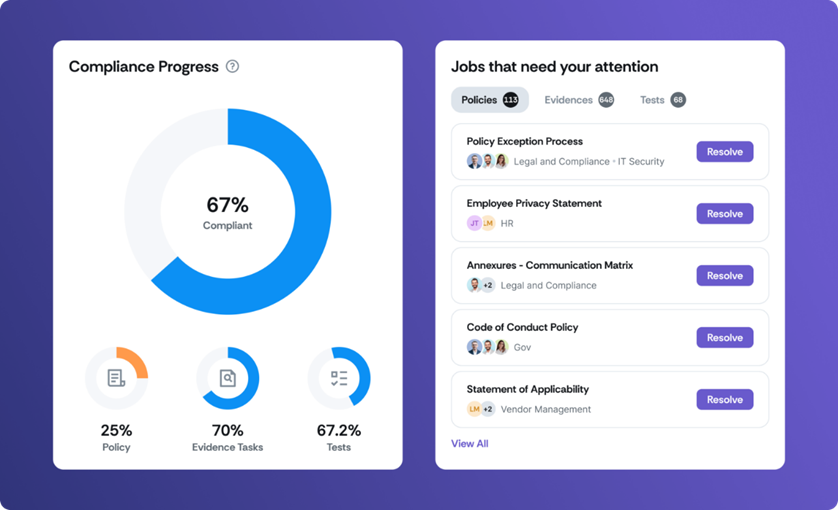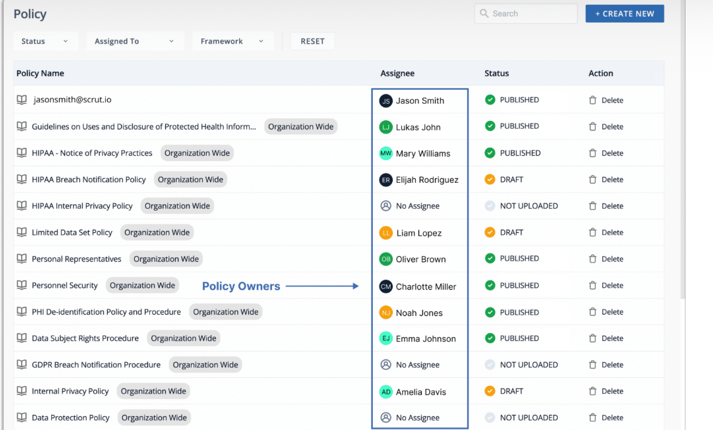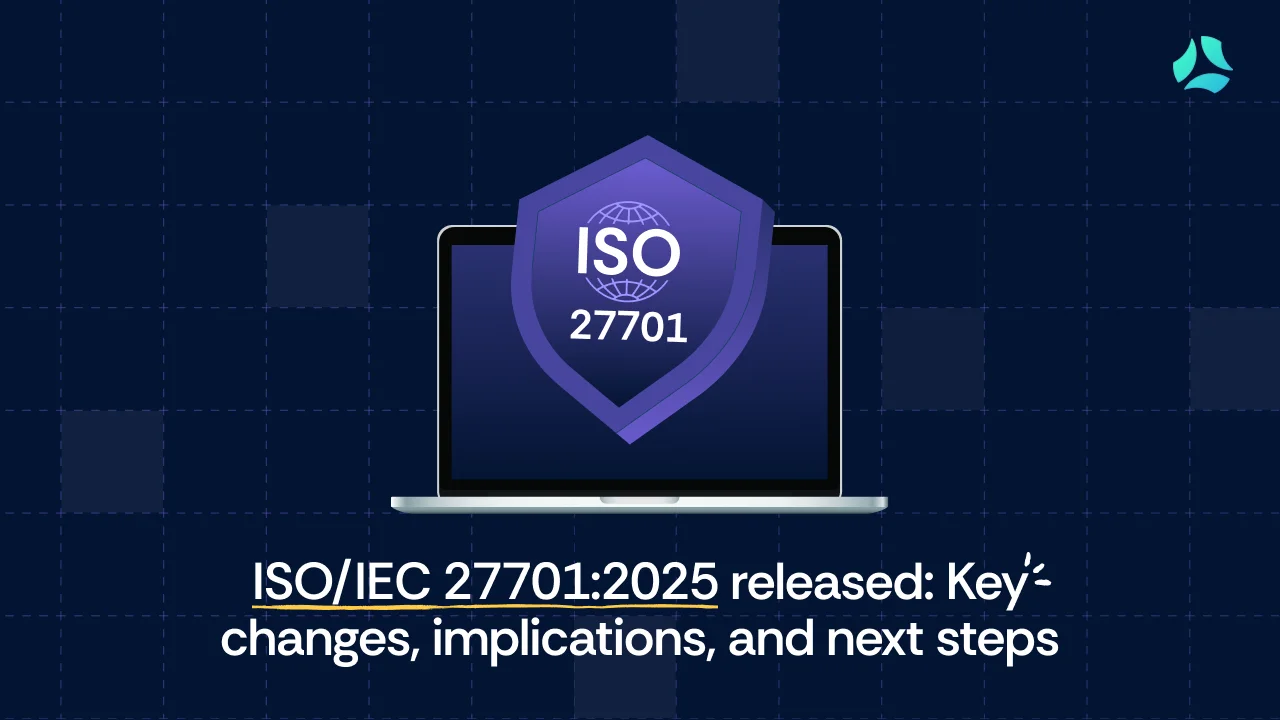HIPAA compliance automation: simplify security & privacy

Telemedicine, mobile health apps, and wearable devices have made patient data more accessible and more vulnerable. With more data online, the risk of breaches, unauthorized access, and misuse is rising fast. So is the pressure.
Traditional HIPAA compliance methods, relying on manual processes, paper checklists, and siloed spreadsheets, are inefficient and difficult to scale. They create blind spots, delay audits, and fall short of protecting data in today’s dynamic threat environment.
As a result, organizations remain vulnerable to compliance gaps, operational inefficiencies, and costly regulatory fines.
HIPAA compliance automation solves these challenges by replacing fragmented processes with real-time, intelligent workflows. It reduces manual effort in key areas, such as risk assessments, policy management, evidence collection, and access monitoring.
So how exactly does automation help with HIPAA compliance? This article breaks it down from faster audits to tighter data protection.
What is HIPAA compliance automation?
HIPAA compliance automation uses technology to streamline how you meet the regulation’s privacy and security requirements. It helps you build policies, manage third-party risk, and automate evidence collection across systems handling protected health information (PHI).
It streamlines the process of managing relationships with business associates and vendors handling PHI.
Instead of relying on manual workflows, HIPAA automation reduces effort across key areas like:
- Risk assessment and gap analysis
- Policy generation and approvals
- Control mapping and evidence collection
- Audit trail creation
- Continuous control monitoring
- Annual HIPAA Security Risk Assessments (SRA)
- Tracking Business Associate Agreements (BAAs) and automating vendor risk assessments
You also get immediate alerts for issues like unauthorized access or misconfigured permissions, so you can act before they escalate. With HIPAA compliance automation, you can adapt faster to regulatory changes, generate audit-ready reports on demand, and reduce the risk of human error. The result? Less manual overhead, fewer compliance gaps, and stronger protection against breaches and penalties.
What HIPAA tasks can be automated?
Automating essential HIPAA tasks removes the burden of manual policy creation, evidence collection, and risk assessments. This means you can focus on staying secure, not stuck in spreadsheets.
Some key HIPAA tasks you can automate include:
1. Risk assessment and gap analysis
Manual HIPAA risk assessments take time and don’t scale well. With automation, you can replace spreadsheet-based workflows with structured, intelligent templates, a pre-loaded risk library, and dynamic questionnaires aligned with HIPAA’s Security Rule.
Automated tools help you identify gaps across administrative, physical, and technical safeguards like missing encryption, weak access controls, or unmonitored audit logs. These insights are powered by real-time data and integrations across your tech stack.
The result? Faster, more accurate assessments that evolve with new threats, minus the overhead.
2. Policy generation and approvals
Manually creating and maintaining HIPAA-compliant policies can be time-consuming, complex, and error-prone. You can automate policy creation with pre-built, customizable policy templates aligned with HIPAA requirements.
You can digitize the entire approval process:
- Route policies for review
- Capture comments
- Enable digital sign-offs
Built-in version control ensures that the latest policy is always accessible, while automated reminders help keep policies current.
Automation streamlines the entire policy lifecycle, from creation to enforcement. It builds a clear audit trail of approvals and acknowledgments, ensuring consistent, audit-ready documentation.
3. Control mapping and evidence collection
Control mapping aligns your security controls to HIPAA requirements. Evidence collection validates that these controls work as intended.
HIPAA compliance automation platforms streamline both. They map your technical and administrative controls to HIPAA standards using built-in frameworks. It helps you continuously monitor administrative, physical, and technical safeguards like encryption, audit logging, and breach detection.
With role-based access control (RBAC) automation, access is automatically granted based on predefined roles, which restricts users only to see the patient data they need for their job. When an employee leaves the organization or their role changes, the platform automatically updates data access rights.
The platform also integrates with your cloud infrastructure, HR tools, and identity and access management (IAM) systems to automatically collect supporting evidence like access logs, encryption settings, and audit trails. No more manual screenshots or file uploads.
Automated control mapping and evidence collection accelerate audit readiness and support continuous compliance.
4. Audit trail creation
HIPAA compliance automation integrates with enterprise applications that manage PHI, such as electronic health records (EHR). They continuously log user activity, from data access and login attempts to policy changes and more.
These logs are stored in a secure, time-stamped, and tamper-evident format to meet HIPAA’s audit trail requirements. You can search them easily to support internal reviews or external audits. This not only speeds up incident response but also strengthens accountability across your systems as required under HIPAA 164.312(b) within the HIPAA security rule’s technical safeguards.
5. Continuous control monitoring
Waiting for your annual audit to find a security misstep is too risky. HIPAA compliance automation platforms detect misconfigurations, such as disabled MFA or open ports, and trigger instant alerts so you can act fast. The platforms notify you when firewall rules are modified or audit logs are turned off. That gives you the chance to fix issues before they turn into compliance violations or breaches.
Proactive continuing monitoring replaces reactive spot checks and helps you maintain continuous HIPAA compliance.
6. Breach notification workflows
The automated detection of incidents sets a chain of events in motion by triggering alerts. The platform routes tasks to responsible teams and tracks deadlines to meet HIPAA’s notification timelines.
7. Workforce training automation
You can automate workforce training delivery and monitor completion without chasing people or juggling spreadsheets. The platform not only assigns courses to employees but also keeps track of completion.
Scrut takes you a step forward by allowing you to measure when employees have completed training. You can now set a Service Level Agreement (SLA) in days for any campaign. If employees miss completing their training within this SLA window, their status is marked as Overdue. You can send automated alerts based on SLA countdowns to prompt them to complete training before the campaign closes.
8. BAA (Business Associate Agreement) tracking
Track every BAA in one centralized, searchable hub with no more digging through folders or spreadsheets. The platform logs execution dates, renewal deadlines, and automatically assigns owners. It sends timely reminders, enabling you to renew agreements before expiration. Integrated workflows make reviews and approvals easy, while audit logs keep track of every change. You will never miss a renewal, and be assured of BAA compliance with HIPAA.
Benefits of automating HIPAA compliance
Automating HIPAA compliance reduces manual effort, minimizes errors, and improves real-time visibility across your systems. It helps you improve data security, streamline audits, and scale your compliance program with consistency.
1. Reduce audit time and resource drain
HIPAA automation tools shorten the path to audit readiness by automating compliance data collection. For example, Scrut's extensive built-in integrations, pre-built templates, and frameworks help reduce the manual effort with maintaining HIPAA compliance.
2. Eliminate spreadsheet chaos
Managing HIPAA compliance through spreadsheets is like trying to run a hospital with paper charts in the digital age: slow, error-prone, and tedious to scale.
Tasks like risk assessments, policy tracking, training records, and audit logs often end up scattered across silos. A HIPAA compliance automation solution brings all of these tasks into one unified platform. This replaces disconnected manual work with real-time data, automated workflows, and centralized dashboards.
The result? Fewer errors, smoother collaboration, and a compliance program that’s finally manageable.
3. Increase accountability with task assignments
With automated task assignments, you always know who’s responsible for what, whether it’s updating policies, completing training, or fixing risks. HIPAA compliance automation platforms drive accountability by assigning ownership for critical tasks like risk mitigation, policy reviews, and staff training. Deadlines and automated reminders keep everything on track.
You get full visibility into what’s done, what’s pending, and who’s responsible, making compliance a shared responsibility, not a siloed burden.
4. Continuous compliance, not point-in-time
Point-in-time audits give a static snapshot, while automation offers ongoing, real-time monitoring. HIPAA compliance automation software continuously monitors systems, controls, and user activities. It provides immediate alerts for misconfigurations, enabling you to maintain continuous compliance.
Key features to look for in HIPAA compliance automation tools
When evaluating HIPAA compliance automation tools, look for features that simplify compliance, protect sensitive data, and keep you audit-ready, always. Here’s what to prioritize:
1. Comprehensive Security Rule coverage
Your tool should cover all aspects of the HIPAA Security Rule: administrative, physical, and technical safeguards. Look for built-in controls for access management, audit logging, encryption, incident response, and employee training. Pre-built templates and automation should make aligning your policies with HIPAA requirements fast and simple.
2. Deep integrations with your tech stack
A good HIPAA compliance automation platform integrates well with third-party applications to facilitate continuous monitoring and simplify evidence collection for compliance reporting. It must integrate seamlessly with cloud providers like AWS, Azure, and Google Workspace; IAM tools like Okta, HR systems; and other enterprise apps.
3. Evidence logs and automated assessments
Look for tools that automatically collect and store evidence, such as system settings, access logs, or encryption status. Automated assessments review collected evidence to spot compliance gaps and generate audit-ready reports, with minimal manual effort.
4. Dashboard visualizations and risk scoring
Intuitive and interactive dashboards visualize compliance status and provide a consolidated view of overall progress, risks, vendors, audits, and frameworks. They provide a high-level view of your HIPAA posture, helping you prioritize remediation efforts based on risk impact and regulatory requirements.
5. Approval workflows and document versioning
Automated approval workflows make sure the right people review and sign off on policies and procedures. Built-in version control tracks updates over time. This means your team works from the most current, compliant version, with built-in audit trails to prove it.
How Scrut automates HIPAA compliance
Scrut automates activities across the HIPAA compliance value chain, from cloud risk assessments and control reviews to employee policy attestations and vendor risk management. With 1,500+ pre-mapped controls across 60+ frameworks, Scrut helps healthcare organizations minimize manual efforts, simplifying HIPAA compliance.
Here are some of its core offerings:
1. Pre-built frameworks tailored to HIPAA
With Scrut, you get access to a library of 140+ expert-vetted policies, giving you a strong foundation for HIPAA compliance. It also offers an in-built policy editor that allows you to upload custom policies and also supports version control.
Scrut’s pre-built frameworks help you align with HIPAA requirements more efficiently, streamlining the compliance journey. These frameworks are designed to help you address the key requirements of the HIPAA security, privacy, and breach notification rules.
The platform offers pre-mapped control and workflow templates aligned with HIPAA requirements. You can customize these to suit your specific operations, whether you’re a healthtech company, a covered entity, or a business associate.
2. Automated artifact collection
Scrut automates evidence collection through its extensive integration with popular third-party applications, including electronic health records (EHR), human resource information systems (HRIS), and cloud services for IT systems.
Scrut can automate a significant portion of evidence collection, reducing manual workload and improving efficiency. It ensures you have an audit-ready view of all evidence mapped to the corresponding HIPAA controls.
3. Real-time control status dashboards
Scrut’s compliance dashboard gives you a clear, centralized view of your HIPAA compliance status. You can see the percentage of compliant controls, track the progress of individual policies, evidence, and tests, and monitor open action items. It brings together everything, risks, vendors, audits, and frameworks into a single pane of glass so you can prioritize what matters most and stay ahead of potential gaps.

Additionally, the module-specific dashboards provide insights tailored to each module. The policy dashboard offers a comprehensive view of policy statuses, while the evidence dashboard enables you to visualize the total evidence. Similarly, the control dashboard, cloud dashboard, risk dashboard, and vendor dashboard help you visualize the status of different aspects of HIPAA compliance.
4. Templates for security and privacy rule policies
Scrut gives you a head start with pre-built, customizable policy templates aligned to HIPAA’s Security and Privacy Rules. These cover core areas like data encryption, access control, incident response, and employee training, so you’re not stuck writing policies from a blank page.
Think of it like getting a move-in-ready home instead of building one from scratch. You still have room to customize, but the essentials are already in place, saving time and reducing risk.
You can adapt these templates to your organization’s needs, accelerating compliance while strengthening audit preparedness.
5. Role-based workflows to ensure accountability
Scrut brings structure to your HIPAA workflows by automatically assigning tasks like policy approvals or risk mitigation to the right people, along with built-in reminders and deadlines to keep things moving.
To enforce good security governance, Scrut supports clear role separation:
- Contributors can complete tasks but can’t approve or publish organization-wide changes.
- Administrators can review, approve, and sign off on major updates.
You can also assign owners to individual policies, giving them full control to update documents or making changes to them. What you get is accountability without bottlenecks.

Use case: scaling HIPAA compliance without stress
As a founder of a health startup, you’re already juggling product development, team building, and customer traction. Now, an investor wants assurance that you're HIPAA compliant, but you don’t have a compliance team or regulatory background.
This is exactly where Scrut can help.
With Scrut’s HIPAA automation capabilities, you get pre-built policy templates, automated risk assessments, and real-time evidence tracking, without spending hours wrangling spreadsheets. Its built-in expert-vetted scoring methodologies help you quantify your risk profile and enable you to assess the impact of your treatment plans with inherent and residual scores.
Scrut integrates with your cloud and HR systems to map your configurations to HIPAA safeguards and automatically collect evidence in real-time. A centralized dashboard helps you keep track of all tasks and compliance progress.
No more last-minute scrambling. Continuous monitoring keeps you ready for investor diligence or regulatory inquiry, and up-to-date documentation gives you the confidence to respond instantly.
HIPAA compliance that grows with your business
The traditional HIPAA compliance process, which relies on periodic checklists and manual tracking, is complex and prone to errors. HIPAA compliance automation transforms a labor-intensive, reactive process into a proactive, scalable, and efficient program.
Scrut automates what matters: risk assessments, control mapping, policy approvals, and evidence collection. It replaces point-in-time audits with continuous monitoring, giving you real-time insight into your compliance posture.
By starting early with the right HIPAA compliance automation platform, you lay a strong foundation for growth. You protect sensitive patient data, reduce compliance risk, and free up your team to focus on what matters most: building a secure, scalable business.
Ready to automate HIPAA compliance? Schedule a demo to see Scrut in action.
FAQs
Can HIPAA compliance be automated?
HIPAA compliance can be automated using software or platforms that digitize and manage tasks like risk assessments, policy management, evidence collection, and control monitoring. HIPAA compliance automation reduces manual effort, improves accuracy, and supports continuous compliance with real-time visibility and audit readiness.
What is the best HIPAA compliance software?
The best HIPAA compliance software, depending on your business needs, includes features like automated risk assessments, policy management, evidence collection, and real-time monitoring. It reduces manual work and ensures continuous compliance and audit readiness.
How do you automate HIPAA risk assessments?
Compliance automation and risk management platforms help automate risk assessment. They centralize risk management activities, including mapping standard-specific controls to risks and tracking compliance progress against each mitigated risk.
Platforms like the Scrut platform offer a pre-loaded risk library, enabling organizations to conduct rapid assessments and develop effective treatment strategies.
What tools help with HIPAA compliance audits?
Compliance automation tools like Scrut help with HIPAA compliance audits by automating evidence collection, tracking policy adherence, logging audit trails, and timely report generation.
What is HIPAA evidence collection automation?
Automated HIPAA evidence collection eliminates manual tracking and ensures audit-ready documentation from an integrated ecosystem. It utilizes software or compliance automation platforms to automatically collect and map compliance data, such as access logs and encryption settings, from an integrated ecosystem. The software or platform integrates with multiple third-party enterprise applications, enabling organizations to collect real-time data.


















